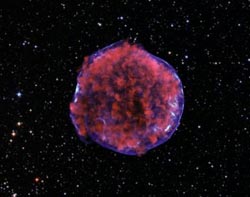Mach 1000 shock wave lights supernova remnant

This is a photograph of the Tycho supernova remnant taken by the Chandra X-ray Observatory. Low-energy X-rays (red) in the image show expanding debris from the supernova explosion and high energy X-rays (blue) show the blast wave, a shell of extremely energetic electrons.<br><br>Credit: X-ray: NASA/CXC/Rutgers/K. Eriksen et al.; Optical (starry background): DSS<br>
In the case of Tycho's supernova remnant, astronomers have discovered that a reverse shock wave racing inward at Mach 1000 (1000 times the speed of sound) is heating the remnant and causing it to emit X-ray light.
“We wouldn't be able to study ancient supernova remnants without a reverse shock to light them up,” says Hiroya Yamaguchi, who conducted this research at the Harvard-Smithsonian Center for Astrophysics (CfA).
Tycho's supernova was witnessed by astronomer Tycho Brahe in 1572. The appearance of this “new star” stunned those who thought the heavens were constant and unchanging. At its brightest, the supernova rivaled Venus before fading from sight a year later.
Modern astronomers know that the event Tycho and others observed was a Type Ia supernova, caused by the explosion of a white dwarf star. The explosion spewed elements like silicon and iron into space at speeds of more than 11 million miles per hour (5,000 km/s).
When that ejecta rammed into surrounding interstellar gas, it created a shock wave – the equivalent of a cosmic “sonic boom.” That shock wave continues to move outward today at about Mach 300. The interaction also created a violent “backwash” – a reverse shock wave that speeds inward at Mach 1000.
“It's like the wave of brake lights that marches up a line of traffic after a fender-bender on a busy highway,” explains CfA co-author Randall Smith.
The reverse shock wave heats gases inside the supernova remnant and causes them to fluoresce. The process is similar to what lights household fluorescent bulbs, except that the supernova remnant glows in X-rays rather than visible light. The reverse shock wave is what allows us to see supernova remnants and study them, hundreds of years after the supernova occurred.
“Thanks to the reverse shock, Tycho's supernova keeps on giving,” says Smith.
The team studied the X-ray spectrum of Tycho's supernova remnant with the Suzaku spacecraft. They found that electrons crossing the reverse shock wave are rapidly heated by a still-uncertain process. Their observations represent the first clear evidence for such efficient, “collisionless” electron heating at the reverse shock of Tycho's supernova remnant.
The team plans to look for evidence of similar reverse shock waves in other young supernova remnants.
Media Contact
More Information:
http://www.cfa.harvard.eduAll latest news from the category: Physics and Astronomy
This area deals with the fundamental laws and building blocks of nature and how they interact, the properties and the behavior of matter, and research into space and time and their structures.
innovations-report provides in-depth reports and articles on subjects such as astrophysics, laser technologies, nuclear, quantum, particle and solid-state physics, nanotechnologies, planetary research and findings (Mars, Venus) and developments related to the Hubble Telescope.
Newest articles

Properties of new materials for microchips
… can now be measured well. Reseachers of Delft University of Technology demonstrated measuring performance properties of ultrathin silicon membranes. Making ever smaller and more powerful chips requires new ultrathin…

Floating solar’s potential
… to support sustainable development by addressing climate, water, and energy goals holistically. A new study published this week in Nature Energy raises the potential for floating solar photovoltaics (FPV)…

Skyrmions move at record speeds
… a step towards the computing of the future. An international research team led by scientists from the CNRS1 has discovered that the magnetic nanobubbles2 known as skyrmions can be…





















